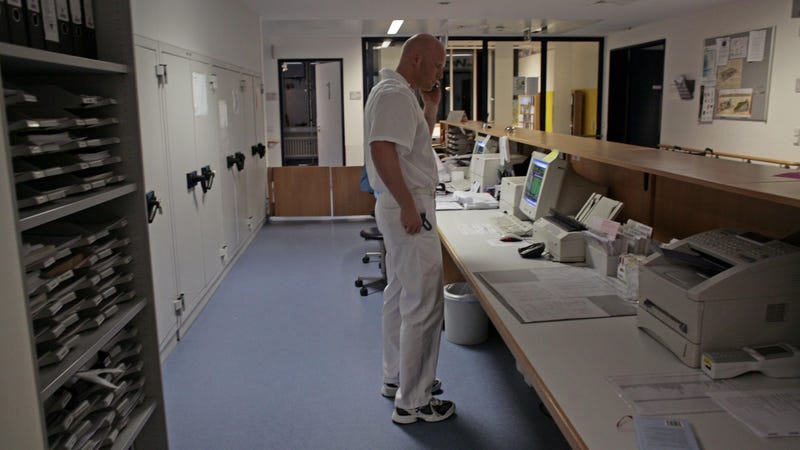 A specialist doctor for casualty surgery managing patients by phone at Martin Luther University in Halle, Germany, in 2006. Stock photo.Photo: Carsten Koall (Getty Images)
A specialist doctor for casualty surgery managing patients by phone at Martin Luther University in Halle, Germany, in 2006. Stock photo.Photo: Carsten Koall (Getty Images)
We’re already living in a national robocall nightmare, but at least most of the time, for most of us, dealing with phone spam is not a matter of life and death. As a Monday report in the Washington Post highlights, that’s not always the case.
Illegal robocalls are hitting health care center switchboards, as well as their patients, hard. In one example, the Post wrote, a tidal wave of four and a half thousand robocalls hit Tufts Medical Center near Boston’s Chinatown neighborhood, severely disrupting communications for a two-hour stretch last year:
At Tufts Medical Center, administrators registered more than 4,500 calls between about 9:30 and 11:30 a.m. on April 30, 2018, said Taylor Lehmann, the center’s chief information security officer. Many of the messages seemed to be the same: Speaking in Mandarin, an unknown voice threatened deportation unless the person who picked up the phone provided their personal information.
The robocalls in question were part of a now well-known scam in which criminals attempt to trick immigrants into handing over banking information. In April 2018, the New York Police Department said it was aware of at least 21 individuals in NYC who had lost a cumulative $2.5 million to the scam since the previous December, many of them senior citizens.
According to the Post, robocallers using spoofing techniques—in which the caller uses a variety of techniques to display a falsified originating number to the recipient—are particularly headache-inducing. Examples provided by the paper included robocallers placing calls to hospital lines from local area codes, as well as calls to random individuals spoofed to appear to be from local medical institutions:
For Jennifer Waisath Harris, a political strategist in Austin, there was no hesitation this May when a call from nearby Ascension Seton Medical Center came across her mobile device. Her mom had been hospitalized weeks earlier on Mother’s Day, and Harris knew she had undergone a bevy of follow-up tests.
“And when I got that call,” she said in a recent interview, it wasn’t a doctor or nurse on the other line. It was some recorded voice, saying, “You qualify for insurance,” she said. “Seeing the hospital’s name come across caller ID, it caused my heart to palpitate a bit.” Adding to her alarm, Harris said she used a call-blocking tool offered by AT&T, her carrier. It didn’t flag anything as awry.
Dave Summitt, the chief information security officer at H. Lee Moffitt Cancer Center and Research Institute, recently told members of Congress that during one 90-day period his facility received 6,600 calls spoofing other Moffitt numbers, as well as 300 more mimicking Department of Justice numbers.
“We’ve had people calling around the community, using our name and number to tell people they owe money,” John Dorak, the director of IT infrastructure for the University of Rochester-affiliated Noyes Health hospital network, told the Post. “That’s not what we do.”
Last year, the Federal Communications Commission dropped a $120 million fine on Adrian Abramovich of Miami, Florida, a robocall operator who placed nearly 120 million calls. The Miami Herald noted that the FCC specifically accused Abramovich of disrupting emergency lines, with the agency writing that “By overloading this paging network, Abramovich could have delayed vital medical care, making the difference between a patient’s life and death.” As the Post noted, the 1991 passage of federal anti-robocalling laws was justified by legislators in part due to concerns they would clog emergency lines.
Robocalls have long since barreled past being a nuisance and have reached unimaginable proportions with the proliferation of technology that makes placing them cheap and easy. Earlier this year, caller-ID company Hiya estimated that robocalls had grown 325 percent globally to 85 billion. Some 26.3 billion were in the U.S., an increase of 46 percent. The FCC released a report earlier this year noting that “robocall volume remains high and may be increasing,” adding that “First Orion projects that 44.6% of calls to mobile phones will be scam calls in 2019, and that neighbor spoofing will increase to the point where nine out of ten scam calls will be from a familiar area code in 2019.”
Last month, the Senate approved the TRACED (Telephone Robocall Abuse Criminal Enforcement and Deterrence) Act, which would slap robocallers with fines of up to $10,000 per call and require carriers to use call authentication systems like SHAKEN/STIR that enable detection of such calls before they reach consumers.
The FCC also voted unanimously this month to finally allow phone carriers to block unwanted calls and illegal robocalls before they make it to consumer’s phones. However, Democratic Commissioner Jessica Rosenworcel noted that the volume of robocalls in the U.S. had reached five billion a month or around 2,000 each second of the day, while the FCC vote did not force carriers to provide the blocking services free of charge.
“I do not think this agency should pat itself on the back for its efforts to reduce robocalls, and then tell consumers to pay up,” Rosenworcel said. “They’re already paying the price in scams flooding our phone lines, wasted time responding to false and fraudulent calls, offering us what we did not ask for, do not want, and do not need.”
[Washington Post]
Share This Story